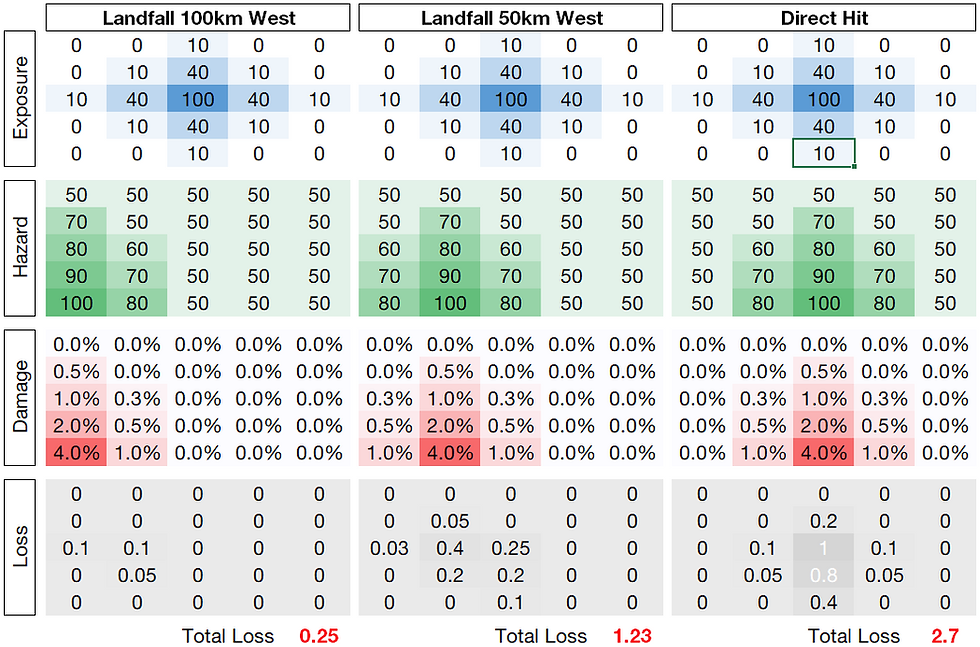Five thoughts on Hurricane Harvey
- Richard Dixon

- Aug 26, 2017
- 4 min read
Finally a major hurricane has made landfall, ending the much talked about (although somewhat arbitrarily-defined) hurricane drought, that not only provides us with plenty to talk about, but valuable data not just for meteorologists but those of us in the catastrophe modelling community. Here's five things that sprung to mind over the past couple of days:

Gulf of Mexico sea surface temperatures and landfalls
It is worth noting that maybe we shouldn't be *too* surprised about Harvey's landfall. Without any scientific consensus on a mechanism for the hurricane drought, it's fair to say that we were "overdue" a landfall somewhere (not that being overdue is in any way shape or form scientific reasoning!). We also probably shouldn't be surprised at the intensity of the hurricane at this time of year in the Gulf given how high the temperatures can get in the seas in this part of the world.
In addition to this, if you look at the SSTs for the August-October period in a box across the Gulf, we can see broadly a steady increase over time in the last 40 years or so, something I alluded to in another blog post. Whether this rising trend continues is moot, but I guess with temperatures increasing, the intensity of the landfall shouldn't really be a shock as such: the mid-2010s average SSTs are about 1c warm than the mid-1950s SSTs.

Also - for interest, in another previous blog post I detailed the sensitivity of landfalling rates to how "history" is defined for choosing warm/cold periods of the Atlantic Multidecadal Oscillation (AMO).
The chart shown here highlights how the Gulf doesn't really "see" the impact of the AMO and that we can typically rely on a fairly steady state of hurricane landfalls at a rate of typically 1 every 20 years or so for a major hurricane landfall. Whether the above increase in Gulf temperatures might change this frequency is probably a research project in itself...

Building value and modelled loss
Whenever I've looked at loss data, I've often noticed - whether it's Ike from 2008 or Kyrill from 2007 - that typically modelled losses tend to be overestimated for high value properties and underestimated for low value properties.
Hurricane Ike hit an area where building values are lower than the average across the US. Of course, there were other factors at play here with surge losses coming into the equation which added to the difficulties in loss estimation.
However, my gut feel has always been that there's a different claim "culture" between low and high value property owners. Lower value property owners claim more than the average, higher value property owners claim less than the average, so one-size fits all damage ratios may not necessarily be perfect across all building costs. And I won't get into undervaluation of insured property here which might muddy the loss estimation waters even more.
Whether this bears out for this event might be hard to tell given the fairly low population density in the landfall area (see above chart from this source), but the region Harvey is affecting doesn't have particularly high per capita income so something like this may be worth taking into consideration and heeding what happened in Ike as well. I'll come on to the rainfall aspect further down this post.
Duration
There's always been an interesting difference of opinion between the two main model vendors on the impact of duration: one of them believes duration is a key influence on the amount of damage, the other doesn't. Or does it all come out in the wash across a stochastic dataset of many thousands of storms?
Either way, Harvey could provide us with a fairly useful data-point to understand its role better given its fairly slow landfall speeds of around 6-8 mph. One such example (Source: @stormbell on Twitter) shows at least 6 hours of 85+ mph gusts as it passed Port Aransas on the Texas coast.


Wet and Windy
All of the talk of wind above may well be lost in the amount of rain that's falling and will continue to fall and which may "muddy" some of the wind numbers if it creeps into the claims. There's a good yardstick in Texas in the shape of Tropical Storm Allison in 2001 that caused significant losses in Houston in particular. Ryan Maue (@ryanmaue) on Twitter has helpfully couched Harvey's rainfall potential in terms of volume of gallons of rainfall that is forecast to fall:
Tropical Storm Allison: TX: 7 trn, LA: 9 7tn.
Hurricane Harvey: TX: 19 trn, LA 6 trn
Just to demonstrate the sheer amount of rainfall, the picture here shows the expected rainfall amounts for 60 hours from midday Friday 25th from the HWRF model. The area promised > 20 inches of rain is staggering: what looks like about 10-15% of Texas. Just to put it into a UK perspective: some places will receive more than the average annual UK rainfall for the drier parts of S/E England. The data shown here is taken from Levi Cowan's superb tropicaltidbits.com website.
More data for the higher end of the vulnerability curve?
When I wrote five thoughts on Hurricane Matthew, I wrote about the frustration about the "same old same old" wind speeds and lack of data to help understand building response to wind towards the tail of the curve. We desperately need to validate and add value to vulnerability curves for winds > 100 mph. One would hope that - given the strength of some of the reported gusts at landfall (I can see a 115kt gust close to landfall as it stands at the time of writing) - we might be able to throw a little more data at vulnerability curves to help bolster our understanding.




Comments